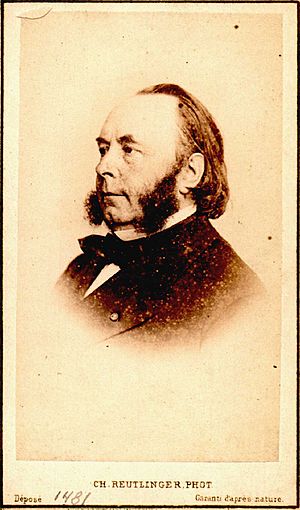Edmond Frémy facts for kids
Edmond Frémy (born February 28, 1814 – died February 3, 1894) was an important French chemist. He is most famous for discovering something called Frémy's salt in 1845. This salt is a strong chemical that can cause other substances to lose electrons. It's also a special kind of free radical that scientists still use today in a technique called electron paramagnetic resonance spectroscopy to study materials.
A Life in Science
Edmond Frémy was born in Versailles, France. When he was just 17, in 1831, he started working in the lab of a famous chemist named Joseph Louis Gay-Lussac. This was a great start to his career!
He quickly moved up, working at the École Polytechnique in 1834 and then at the Collège de France in 1837. By 1846, he became a professor at the École Polytechnique. In 1850, he took over from Gay-Lussac as the head of chemistry at the Muséum national d'histoire naturelle. He later became the director of this museum from 1879 to 1891. Frémy passed away in Paris.
Frémy's Chemical Discoveries
Frémy did a lot of different studies in chemistry. He looked into many compounds, including those related to osmic acid, ferrates, stannates, and plumbates. He also studied ozone, which is a special form of oxygen.
He tried to get pure fluorine, a very reactive element, by using electricity on melted fluorides. He also discovered hydrofluoric acid without water and a group of chemicals called acides sulphazotés. For a long time, scientists debated exactly what these chemicals were.
Frémy also explored how leaves and flowers get their colors. He studied the makeup of bone, brain matter, and other animal substances. He even looked into fermentation, which is how things like bread rise or grapes turn into wine. Interestingly, he disagreed with the famous scientist Louis Pasteur on some of his ideas about fermentation.
Chemistry for Industry
Frémy believed that chemistry should be useful in everyday life and in factories. He taught many students to become chemists who could work in industries.
He helped us understand more about making iron and steel, sulfuric acid, glass, and paper. He also worked on how to turn fats into palmitic acid using sulfuric acid, which was important for making candles.
Later in his life, Frémy focused on making alumina in its crystal form. He was very successful! He managed to create rubies that were exactly like natural ones. They had the same chemical makeup and even the same physical properties, like how hard they were and how they looked. This was a huge achievement in making artificial gemstones.
See also
 In Spanish: Edmond Frémy para niños
In Spanish: Edmond Frémy para niños


